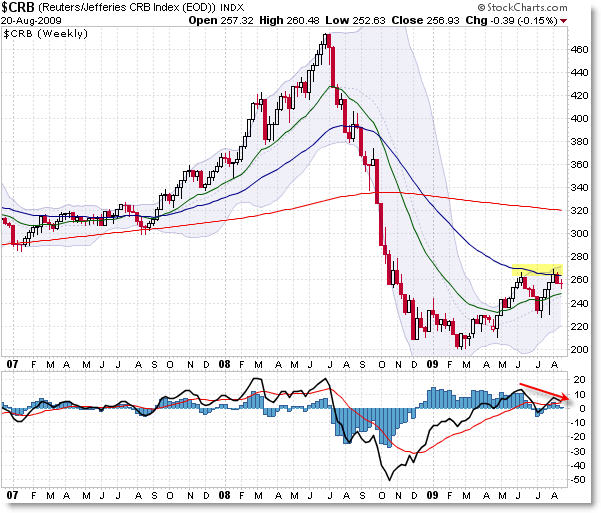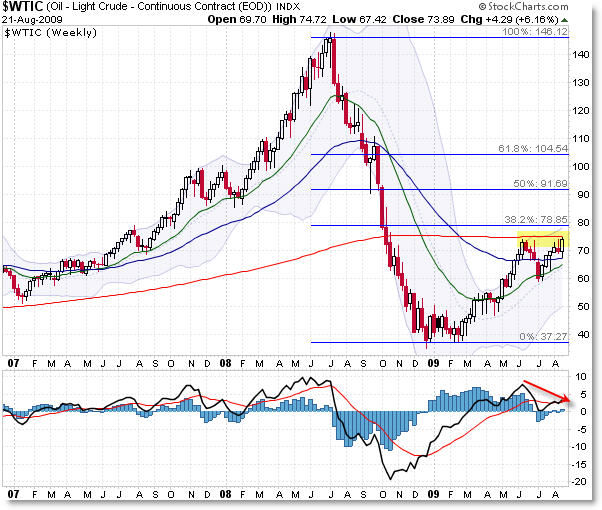Even as investors get more and more bullish about the outlook for the U.S. economy, the economy’s underlying foundation continues to erode.
In a report to be released this week, the Obama administration will boost its 10-year projectiojn for the federal budget deficit to about $9 trillion - an increase of roughly $2 billion, or 29%, from its prior projection, Fox News reported over the weekend, citing a source from the Office of Management and Budget (OMB).
The new cumulative deficit projection - for 2010-2019 - replaces the administration’s previous estimate of $7.108 trillion. Changes in budget projections - whether they result in a surplus or a deficit - are often refined as economic conditions change. This new projection was necessary because the recession has gone on for so long, causing federal tax receipts to plunge - and because the economic rebound will be prolonged and weak, resulting in lower forecasts for future federal revenue.
Although most of the news media focuses on the Obama administration’s $787 stimulus measure, the fact is that the federal government was pushing forward with nearly $12 trillion in rebound-related financing commitments, Money Morning reported this spring.
The administration earlier this year predicted that unemployment would peak at about 9% without the financial-jump-starting initiatives and 8% with them. But U.S. joblessness zoomed skyward anyway, and stood at 9.4% last month, although many economists now say that a double-digit unemployment rate - one of 10% or more - is easily possible.
The nation’s debt now stands at $11.7 trillion. In the scheme of things, that’s more important than talking about the deficit, which only looks at a one-year slice of bookkeeping and ignores previous debt that is still outstanding.
Back in June, the non-partisan Congressional Budget Office (CBO) predicted that the federal deficit would reach $1.825 trillion this year. The CBO and the Obama administration will tomorrow (Tuesday) separately release new budget-deficit predictions. Last Wednesday, a senior White House official, speaking on the condition of anonymity, told The Associated Press that the administration estimate would reach $1.58 trillion - or triple last year’s deficit.
The report for the budget year that ends Sept. 30 also will predict Washington to spend $3.653 trillion this year, although revenue will reach only $2.074 trillion, the unnamed senior official told The AP.
“Whether it’s $1.6 trillion or $1.8 trillion, it’s pretty bad,” said Robert Bixby, executive director of the bipartisan fiscal watchdog The Concord Coalition, told Fox News. “I hope no one tries to spin that as good news.”
Total U.S. debt has soared to $11.7 trillion (the budget deficit is the “shortfall” in the annual deficit, while the debt is cumulative), having balloned to that level as a result of the multiple annual deficits that have become the norm, it seems.
Market Matters
Just who is the world’s great economic superpower these days? At times, it seems, “as China goes, so go the world equity markets.” Early in the week, the Shanghai Composite Index (SSE) suffered its largest percentage decline since late 2008, with the index plunging more than 20% for the month on concerns about the sustainability of China’s recovery.
The global markets watched as the Japan, Europe, and the U.S. indexes followed the SSE downward. By mid-week, however, all eyes were back on the domestic market as another sell-off in China was overshadowed by signs of growing U.S. economic strength and reports of enhanced energy demand.
The global bailout plans moved into a new stage as the Swiss government relinquished its control over banking giant UBS AG (UBS: 17.44 -0.10 -0.57%) by selling off its investment for a $1.13 billion profit, or a 30% annualized return. While the U.S. government has yet to reap similar benefits, several major banks have paid off their Troubled Asset Relief Program (TARP) loans and the CEO for one of the poster children for financial distress, American International Group Inc. (AIG: 34.34 +1.49 +4.54%), announced that his firm should be able to pay back the government and may even be able to “do something for shareholders as well.”
While many auto dealers complained about the rebate process on the “Cash for Clunkers” program, General Motors Corp. stepped forward and will begin providing advances to participants who continue to wait for the government to move through its traditional red-tape.
The healthcare debate (and political infighting) raged on (complete with widespread town hall civil disobedience). Rumors that the government would remove its public-health-plan option sent related health-care stocks soaring early in the week, though the jury remains out as to how this will really play after U.S. President Barack Obama guaranteed approval of an overhaul and then bashed congressional Republicans for their efforts in blocking any plan whatsoever.
On the earnings front, the housing sector received mixed signals as Home Depot Inc. (HD: 27.419 -0.081 -0.29%) bested expectations, while rival Lowe Companies Inc. (LOW: 21.17 +0.01 +0.05%) fell short and reduced its outlook. Cost-cutting was widespread among retailers as The TJX Cos. Inc. (TJX: 35.95 +0.09 +0.25%), The Gap Inc. (GPS: 19.29 -0.19 -0.98%), and even Target Corp. (TGT: 45.56 -0.10 -0.22%) benefited from increased margins, though sales remained lackluster at best.
Hewlett-Packard Co. (HPQ: 44.98 +0.20 +0.45%) struggled in its PC and printer-business segments, though management expects a healthy rebound in its fiscal fourth quarter.
Fixed income benefited from some early “flight-to-quality” trades and a report that showed strong foreign demand for U.S. Treasuries in June (despite ongoing rumors to the contrary). Stocks fell sharply in sympathy with the China sell-off, though buyers reemerged in a big way on positive signs from the earnings and economic reports.
Likewise, oil prices shook off some early week negativity and surged to 2009 highs, as a surprising plunge in inventory levels revealed growing demand - perhaps to coincide with the beginning of a global economic rebound? On that note, U.S. Federal Reserve Chairman Ben S. Bernanke’s comments about the prospects for recovery (though slow at first) were extremely well-received as investors seemed to all but forget about following Shanghai and the U.S. markets assumed the leadership role once again. The major domestic indexes shrugged off the weak start and pushed to new highs for the year.
| Market/ Index | Year Close (2008) | Qtr Close (06/30/09) | Previous Week | Current Week | YTD Change |
| Dow Jones Industrial | 8,776.39 | 8,447.00 | 9,321.40 | 9,505.96 | +8.31% |
| NASDAQ | 1,577.03 | 1,835.04 | 1,985.52 | 2,020.90 | +28.15% |
| S&P 500 | 903.25 | 919.32 | 1,004.09 | 1,026.13 | +13.60% |
| Russell 2000 | 499.45 | 508.28 | 563.90 | 581.51 | +16.43% |
| Global Dow | 1526.21 | 1,629.31 | 1,803.83 | 1,819.50 | +19.22% |
| Fed Funds | 0.25% | 0.25% | 0.25% | 0.25% | 0 bps |
| 10 yr Treasury (Yield) | 2.24% | 3.52% | 3.56% | 3.56% | +132 bps |
Economically Speaking
In addition to the Home Depot and Lowe’s earnings reports, housing news was prevalent during the week and the results were somewhat confusing. The National Association of Home Builders reported that its Housing Market Index climbed for the second month in a row and reached its highest level in over a year. Likewise, applications for mortgages increased for the third straight month on declining interest rates.
However, foreclosure rates remain on the rise and, according to the Mortgage Bankers Association, 13.2% of mortgages are delinquent or worse (in foreclosure); in fact, subprime mortgages are no longer the only area of concern as the unsettled labor picture has prompted homeowners with strong credit to fall behind on their prime mortgages as well.
Though housing starts fell in July, the decline was entirely attributable to apartment activity and construction of single-family homes actually rose for the fifth straight month. Additionally, existing home sales in July surged by more than 7% as buyers took advantage of the misfortunes of others (in foreclosure), though prices continue to fall because of transactions related to these distressed properties.
In non-housing news, separate regional reports from the New York and Philadelphia Feds boosted the outlook for the domestic manufacturing sector and the overall economy. Wholesale inflation remained benign as the producer price index (PPI) fell by a wider-than-expected 0.9% in July and prices have plummeted over the past 12 months by the largest percentage (6.8%) since records have been kept, dating back to 1947.
Be forewarned: Oil just hit a 2009-high.
U.S. Federal Reserve policymakers met for their annual conference and Fed Chair Bernanke shared a favorable assessment about the recovery process from “the most severe financial crisis since the Great Depression.” Of course, Bernanke tempered some of his remarks and reiterated that, while the recession seems to be coming to an end, the rebound would likely be slow, with unemployment remaining a concern.
Bernanke also spoke of the need for financial regulatory reform in order to ensure the current financial debacle isn’t repeated. The Fed also extended its Term Asset-Backed Securities Loan Facility (TALF) lending program in order to help stem the potential “challenges” that remain among commercial mortgage-backed securities.
Weekly Economic Calendar
| Date | Release | Comments |
| August 18 | Housing Starts (07/09) | Single-family starts up, though apartments dropped |
| PPI (07/09) | Much larger than expected decline in wholesale prices | |
| August 20 | Initial Jobless Claims (08/15) | Surprising rise in claims for unemployment benefits |
| Leading Indicators (07/09) | 4th consecutive monthly increase | |
| August 21 | Existing Homes Sales (07/09) | Best showing in almost 2 years |
| The Week Ahead | ||
| August 25 | Durable Goods Orders (07/09) | |
| Consumer Confidence (08/09) | ||
| August 26 | New Home Sales (07/09) | |
| August 27 | Initial Jobless Claims (08/15) | |
| August 28 | Personal Spending/Income (07/09) |













